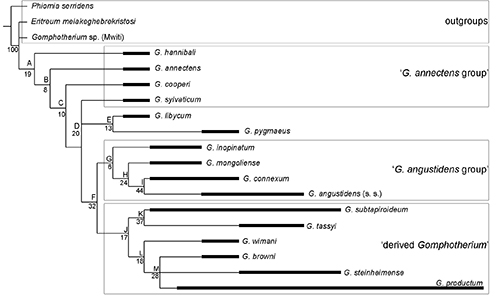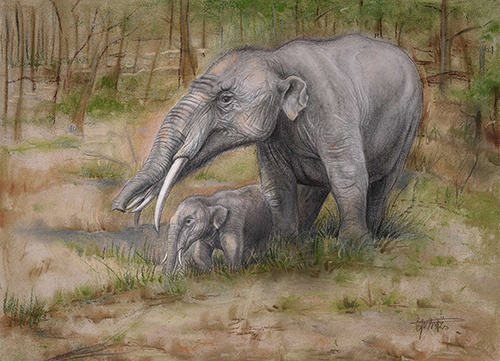Research on Gomphotherium
For a long time, gomphotheres are considered to be the key link in proboscidean evolution. They are deemed as the ancestral stock of the true elephantids surviving now. The origins of stegodontids, rhynchotheres and cuvieroniines are believed to be more or less related to gomphotheres. However, gomphotheres are also considered as a problematic taxon or “dustbin” category in proboscideans. Historically, at least 60 species had been attributed into the genus Gomphotherium or its synonyms, and more than 10 species are widely acknowledged now. No agreement yet has been reached about whether these species have any synonyms or homonyms and about the systematic relations between species. The reason is that Gomphotherium has few autapomorphies (the only acknowledged autapomorphy is the oval or pear-shaped lower incisors), unspecialized feature of cheek teeth, and quite large intraspecific variation.
In the Issue 3, volume 37 of Journal of Vertebrate Paleontology published on August 11, 2017, as the cover story, newest achievements on Gomphotherium were publicized by Prof. WANG Shi-Qi’s group in IVPP, Chinese Academy of Sciences. The author studied 16 representative species from Eurasia, Africa and America, which almost covered all the Gomphotherium species in the world. In the paper, the authors extend the achievements on Gomphotherium performed by the famous scholar, Prof. Pascal Tassy from National Museum of Natural History (France) in 1985 and carefully compared the comprehensive morphological features of Gomphotherium skull, mandible, incisors and cheek teeth; on this basis, through the cladistics analysis approach, 3 monophyletic groups and 1 paraphyletic group are identified within the genus Gomphotherium, which well settled the phylogenetic relationship among Gomphotherium species.
In this paper, the author described a new Gomphotherium species—Gomphotherium tassyi discovered from Linxia Basin in late Middle Miocene epoch. The new species is named after Prof. Pascal Tassy to pay a tribute to his great achievements in research about gomphotheres. The study shows that, Gomphotherium tassyi and Gomphotherium subtapiroideum constitute the branch of gomphotheres whose cheek teeth evolved towards cutting action, so that they show some morphologic similarity to mammutids. The existence of such similarity confuses the tooth morphology of gomphotheres and mammutids, and to some extend shakes the realization on the major classification Proboscidea.

Figure 1 Phylogeny of the genus Gomphotherium

Figure 2 Ecological reconstruction of the habitat for Gomphotherium tassyi
Download attachments: